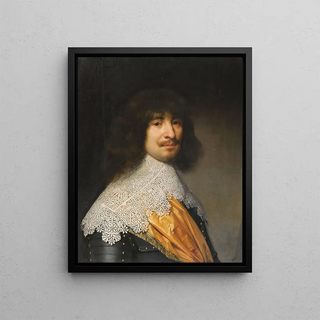Art print | Portrait of a gentleman, probably Sir Thomas Aston - Gerard van Honthorst


View from behind

Frame (optional)
Art print Portrait of a gentleman, probably Sir Thomas Aston - Gerard van Honthorst – Captivating introduction
The "Portrait of a gentleman, probably Sir Thomas Aston" by Gerard van Honthorst presents itself as a window into 17th-century aristocracy. This work, imbued with psychological depth and technical mastery, invites the viewer to delve into the universe of a man whose social status is read through every detail. The light, omnipresent in van Honthorst's portraits, plays a fundamental role here, revealing not only the facial features but also the soul of its subject. Contemplating this painting, one cannot help but feel a mixture of curiosity and respect for this man whose identity, although partially forgotten, continues to fascinate.
Style and uniqueness of the work
Gerard van Honthorst's style is inseparable from Baroque art, characterized by a dramatic use of light and meticulous attention to detail. In this portrait, the chiaroscuro technique is particularly evident, emphasizing contrasts between luminous areas and shadows. The gentleman's face, carefully illuminated, almost seems to emerge from darkness, giving the work a rare emotional intensity. The sumptuous clothing, carefully rendered, also testifies to the wealth and refined taste of his era. Every fold of fabric, every reflection of light on satin, is an invitation to explore not only the personality of the subject but also the social and cultural context surrounding him. The composition, both simple and effective, highlights the character while revealing an atmosphere of mystery.
The artist and his influence
Gerard van Honthorst, born in 1592 in Utrecht, is one of the masters of portraiture in the 17th century. Raised during a period when Flemish and Dutch art experienced unprecedented growth, he gradually established himself as a virtuoso of chiaroscuro. His encounter with Caravaggio, whom he largely inspired, marked a decisive turning point in his career. By incorporating elements of daily life into his aristocratic portraits, Honthorst was able to bring a human dimension to his subjects, making his works accessible and touching. His

Matte finish

View from behind

Frame (optional)
Art print Portrait of a gentleman, probably Sir Thomas Aston - Gerard van Honthorst – Captivating introduction
The "Portrait of a gentleman, probably Sir Thomas Aston" by Gerard van Honthorst presents itself as a window into 17th-century aristocracy. This work, imbued with psychological depth and technical mastery, invites the viewer to delve into the universe of a man whose social status is read through every detail. The light, omnipresent in van Honthorst's portraits, plays a fundamental role here, revealing not only the facial features but also the soul of its subject. Contemplating this painting, one cannot help but feel a mixture of curiosity and respect for this man whose identity, although partially forgotten, continues to fascinate.
Style and uniqueness of the work
Gerard van Honthorst's style is inseparable from Baroque art, characterized by a dramatic use of light and meticulous attention to detail. In this portrait, the chiaroscuro technique is particularly evident, emphasizing contrasts between luminous areas and shadows. The gentleman's face, carefully illuminated, almost seems to emerge from darkness, giving the work a rare emotional intensity. The sumptuous clothing, carefully rendered, also testifies to the wealth and refined taste of his era. Every fold of fabric, every reflection of light on satin, is an invitation to explore not only the personality of the subject but also the social and cultural context surrounding him. The composition, both simple and effective, highlights the character while revealing an atmosphere of mystery.
The artist and his influence
Gerard van Honthorst, born in 1592 in Utrecht, is one of the masters of portraiture in the 17th century. Raised during a period when Flemish and Dutch art experienced unprecedented growth, he gradually established himself as a virtuoso of chiaroscuro. His encounter with Caravaggio, whom he largely inspired, marked a decisive turning point in his career. By incorporating elements of daily life into his aristocratic portraits, Honthorst was able to bring a human dimension to his subjects, making his works accessible and touching. His






